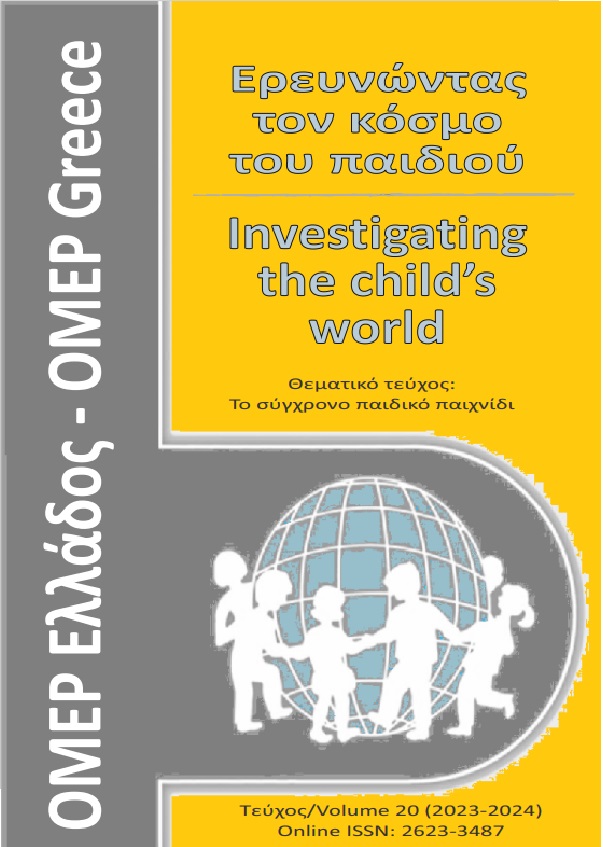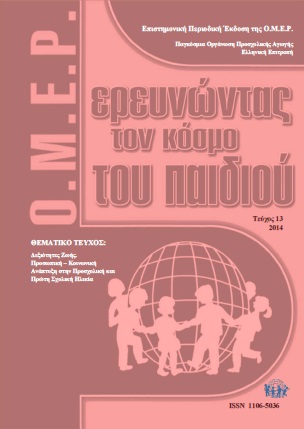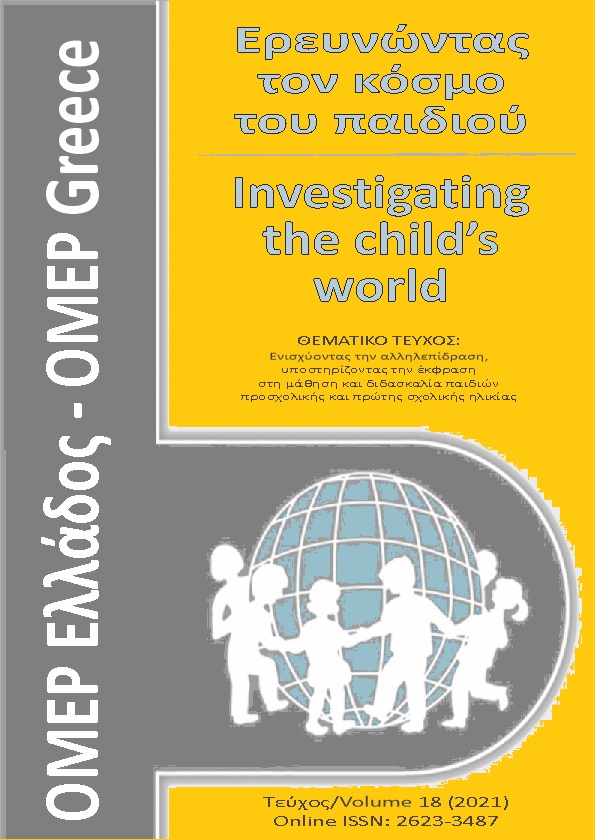Το ριψοκίνδυνο παιχνίδι στο Ελληνικό νηπιαγωγείο: Οπτικές και πρακτικές
Περίληψη
Ερευνητές από διαφορετικά πολιτισμικά πλαίσια συζητούν ολοένα και περισσότερο σχετικά με την ισορροπία μεταξύ της ασφάλειας των παιδιών κατά το παιχνίδι και της ανάγκης τους να ρισκάρουν και να δοκιμάσουν τις δυνάμεις τους σε διάφορα επίπεδα. Από πρόσφατη αναζήτηση στην ελληνική βιβλιογραφία προέκυψε ότι οι έρευνες που μελετούν το ριψοκίνδυνο παιχνίδι των παιδιών στο ελληνικό νηπιαγωγείο είναι περιορισμένες. Μέσα στο πλαίσιο αυτό, η παρούσα έρευνα στόχο της είχε να διερευνήσει πώς αντιλαμβάνονται την έννοια του ριψοκίνδυνου παιχνιδιού Έλληνες και Ελληνίδες νηπιαγωγοί και κατά πόσο το επιτρέπουν ως είδος παιχνιδιού στους χώρους του νηπιαγωγείου. Στην έρευνα συμμετείχαν 20 εκπαιδευτικοί που εργάζονται σε δημόσια νηπιαγωγεία και η συλλογή των δεδομένων έγινε με ημι-δομημένες συνεντεύξειςΟι συνεντεύξεις απομαγνητοφωνήθηκαν και η επεξεργασία τους έγινε με τη μέθοδο της θεματικής ανάλυσης. Από την ανάλυση των δεδομένων προκύπτει, μεταξύ άλλων, ότι οι συμμετέχοντες, ως ριψοκίνδυνο παιχνίδι ορίζουν συμπεριφορές των παιδιών που θεωρούν ότι ενέχουν κίνδυνο για τη σωματική ακεραιότητά τους, όπως για παράδειγμα το ανέβασμα στα τραπέζια ή τα παγκάκια της τάξης, ο συνωστισμός σε παιχνίδια της αυλής ή το σκαρφάλωμα σε δέντρα και κατασκευές. Ενώ στην πλειονότητά τους οι εκπαιδευτικοί φαίνεται να αναγνωρίζουν τον ενθουσιασμό των παιδιών όταν ρισκάρουν στο παιχνίδι και να μπορούν να διακρίνουν τα οφέλη που πηγάζουν από αυτές τις δράσεις, ταυτόχρονα φαίνεται να φοβούνται τον «υπέρμετρο ενθουσιασμό αυτής της ηλικίας» και προσπαθούν να τον τιθασεύσουν με απαγορεύσεις οι οποίες επιβάλλονται, ως επί το πλείστον, προκαταβολικά. Τα αποτελέσματα της έρευνας συζητούνται από την οπτική της επαγγελματικής ανάπτυξης των εκπαιδευτικών.
Λεπτομέρειες άρθρου
- Πώς να δημιουργήσετε Αναφορές
-
Μπιρμπίλη Μ., & Κυριακίδου Μ. (2024). Το ριψοκίνδυνο παιχνίδι στο Ελληνικό νηπιαγωγείο: Οπτικές και πρακτικές. Ερευνώντας τον κόσμο του παιδιού, 20, 87–100. https://doi.org/10.12681/icw.35417
- Ενότητα
- Επιστημονική αρθρογραφία & εκπαιδευτικές δράσεις

Αυτή η εργασία είναι αδειοδοτημένη υπό το CC Αναφορά Δημιουργού – Μη Εμπορική Χρήση 4.0.
Οι Συγγραφείς που δημοσιεύουν εργασίες τους σε αυτό το περιοδικό συμφωνούν στους παρακάτω όρους:
Οι Συγγραφείς διατηρούν τα Πνευματικά Δικαιώματα και χορηγούν στο περιοδικό το δικαίωμα της πρώτης δημοσίευσης ενώ ταυτόχρονα τα πνευματικά δικαιώματα της εργασίας προστατεύονται σύμφωνα με την Creative Commons Attribution License που επιτρέπει σε τρίτους - αποδέκτες της άδειας να χρησιμοποιούν την εργασία όπως θέλουν με την προϋπόθεση της διατήρησης των διατυπώσεων που προβλέπονται στην άδεια σχετικά με την αναφορά στον αρχικό δημιουργό και την αρχική δημοσίευση σε αυτό το περιοδικό.
Οι Συγγραφείς μπορούν να συνάπτουν ξεχωριστές, και πρόσθετες συμβάσεις και συμφωνίες για την μη αποκλειστική διανομή της εργασίας όπως δημοσιεύτηκε στο περιοδικό αυτό (π.χ. κατάθεση σε ένα ακαδημαϊκό καταθετήριο ή δημοσίευση σε ένα βιβλίο), με την προϋπόθεση της αναγνώρισης και την αναφοράς της πρώτης δημοσίευσης σε αυτό το περιοδικό.
Το περιοδικό επιτρέπει και ενθαρρύνει τους Συγγραφείς να καταθέτουν τις εργασίες τους μέσω διαδικτύου (π.χ. σε ένα ακαδημαϊκό καταθετήριο ή στους προσωπικές τους ιστοσελίδες) πριν και μετά από τις διαδικασίες της δημοσίευσης, καθώς αυτό μπορεί να οδηγήσει σε παραγωγική ανταλλαγή ιδεών και σκέψεων καθώς επίσης και σε γρηγορότερη και μεγαλύτερη χρήση και ευρετηρίαση της δημοσιευμένης εργασίας (See The Effect of Open Access).





